Do you want to know the differences between Jira Service Management and ServiceNow?
Choosing a Tool
When the future or success of your company is at stake, it’s difficult to make a decision with the goal of achieving the proposed objective. This is the time to reflect and consider whether you really have a tool that can increase employee performance, optimize and automate processes, improve service quality, and provide indicators for strategic decision-making. It is vital to ensure you have a tool that fits your company culture, processes, and goals. Choosing a service management tool is a very challenging task despite the variety available. In this article, we hope to help you decide between the two most widely used options: Jira Service Management and ServiceNow.
It is important for all companies striving for success to ensure they have implemented a tool that allows for growth to meet objectives.
Remember, every service can be measured and therefore improved.
Service Management 📊
The positive aspect of this analysis is that both solutions commit to working under the ITIL framework (Information Technology Infrastructure Library) best practices. First, we will discuss Jira Service Management (JSM), which presents itself as a service management solution for any high-speed team looking to optimize their processes to solve problems faster. JSM is built on the established Atlassian platform and integrates seamlessly with the rest of the suite’s products.
Although now known as a flexible ITSM solution, JSM can also be applied beyond IT teams to Enterprise Service Management (ESM). JSM’s service management functionalities, including self-service portals, service level agreements (SLAs), and queues, support the flawless implementation of the ITIL framework.
Alternatively, ServiceNow also provides a powerful solution for IT departments seeking to accurately manage requests, issues, and changes. With Operations Management (ITOM), ITSM, and IT Business Management (ITBM), ServiceNow helps organizations efficiently manage their teams, projects, and customer interactions. Though ServiceNow’s native cloud SaaS platform is known for its comprehensive ITSM/ITIL capabilities, it can also be applied to ESM solutions. From workflow automation to incident and problem management, to configuration and knowledge management.
Key Features 💪
To understand a bit more about each software, let’s summarize their strengths.
Jira Service Management
Jira Service Management is a flexible solution that leads the way in collaboration, workflow automation, and integrations, and is suitable for all types of companies, especially if you already use other Atlassian products and want seamless collaboration within your organization.
- ITSM Specialization: Specializes in IT service management, focusing on incident, problem, change, and asset management. This makes it ideal for IT and operations teams needing tools centered on ITSM.
- Integration with Development Tools: Integrates seamlessly with other Atlassian tools like Jira and Bitbucket, facilitating collaboration between development (reducing time and obtaining valuable indicators) and IT operations. This is especially valuable in a DevOps environment but also across departments like marketing, legal, or finance.
- Scalability and Flexibility: Suitable for businesses of all sizes, from small to large organizations, and can scale according to business needs.
- Customization and Flexibility: Known for its high customization capability. Teams can tailor workflows, fields, and processes to meet specific needs.
- Affordable and Transparent Pricing: Offers flexible pricing options, including a free edition, and paid subscriptions calculated by the number of agents, with no additional cost for approvers or requesters, and no surprises.
- Fast and User-Friendly Interface: Allows teams to get started quickly with a clean, modern, and intuitive interface.
- Updates: Releases several versions per year that include new features, bug fixes, and user-requested improvements. Jira Service Management is part of the Atlassian platform, widely known and used in the software development and project management world. This integration makes it a logical choice for agile development teams seeking an incident, problem, and change-oriented IT service management solution.
ServiceNow
ServiceNow may be suitable for you if you focus primarily on complex ITIL processes and use many of the software’s features; otherwise, performance will be inadequate in terms of high costs and setup efforts.
- Process Automation: Stands out for its ability to automate business workflows across multiple departments and functions within an organization.
- Scalability and Complexity: A suitable option for large companies and organizations with complex workflow automation and enterprise service management needs across various departments.
- Single Cloud Platform: A single code base that easily extends specific service management use cases and workflows beyond ITSM, including Security, HR, Customer Service, Procurement, Legal, and more.
- Dedicated Cloud: With ServiceNow, customers have a dedicated instance in our private cloud. No need to rely on the public cloud to host previously on-premise software.
- Updates: Releases only two new versions per year and is more suitable for slow enterprise deployment contexts.
Additional modules can be contracted to integrate into the platform to meet needs in other areas (HR, Security, etc.).
| Jira Service Management | ServiceNow | |
| Average implementation time less than 6 months | ✅ | ❌ |
| Seamless integration with development tools like Jira or Bitbucket | ✅ | ❌ |
| Transparent and easy-to-understand pricing | ✅ | ❌ |
| Requests, incidents, problems, changes, and asset management capabilities included | ✅ | ✅ |
| Business, development, and IT objectives aligned on the same platform | ✅ | ❌ |
Usability 👨💻👩💻
To get an idea of usability, it’s best to see it with an image, so in the following screenshots, we can appreciate the different interfaces (incident view for agents) to compare Jira Service Management and ServiceNow.
| ServiceNow | Jira Service Management |
 | 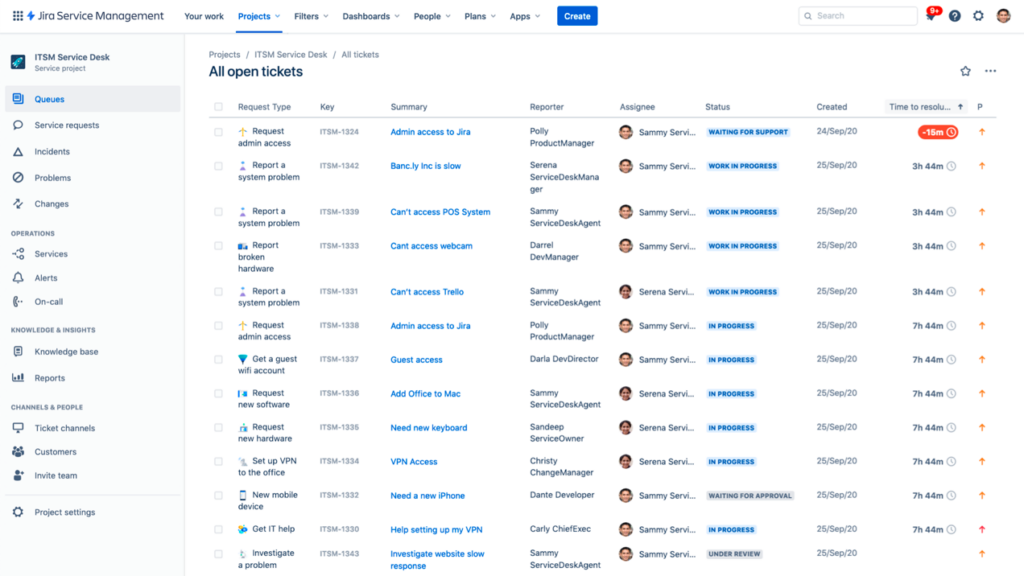 |
Starting from the point that both applications have a similar layout, in the ServiceNow screenshot, we can see an interface where the menu is mainly on the left side of the screen. The main change is that it does not have as modern and intuitive an interface as Jira Service Management. Besides the queues in the left menu, JSM has a top menu with shortcuts to filters, projects, Dashboard, or installed Apps in our instance.
Average Implementation Time ⏲️
The average implementation time is one of the most determining factors for deciding which product to choose. Implementing Jira Service Management takes less than half the time of ServiceNow. According to the G2Crowd Service Desk implementation index report, Jira Service Management takes an average of 1.2 months to get up and running. In contrast, ServiceNow requires an average of 4.5 months for a basic implementation and more than 8-12 months for a more mature implementation. Additionally, due to its inherent ease of use, Jira Service Management acts as a more intuitive and straightforward solution for managing requests, incidents, problems, and changes. This means your service teams are likely to get up to speed faster, resulting in quicker and deeper adoption and a faster return on investment.
At TecnoFor (Atlassian Platinum Solution Partner and Atlassian ITSM Specialized), we have developed the ITSM For Jira solution. This solution significantly reduces Jira Service Management implementation time, offering a fresh, intuitive look and many integrated features for optimal service management. A pre-configuration that allows implementation in less than a week.
ServiceNow is relatively more complex to configure and adopt, requiring IT professionals to have some ITIL knowledge to get the most out of it. This also implies higher training and onboarding costs due to the platform’s lesser intuitiveness for all users.
Integrations with Apps 🔃
This section is crucial for integrating the service management tool with other tools and increasing the power of the generated service information. In the case of ServiceNow, it has applications on its platform and certified integrations that are pre-designed and tested by Build Partners and approved by ServiceNow, ready for faster implementation in their production instances.
On the other hand, Jira Service Management has the Atlassian Marketplace, a website currently featuring over 5700 apps, making it highly likely that one will meet the specific need. Additionally, these apps can have a Cloud Security Participant or Cloud Fortified badge, helping you easily identify apps that have gone beyond Atlassian’s general standards to offer a secure and reliable cloud experience.
| Atlassian Marketplace | ServiceNow Store |
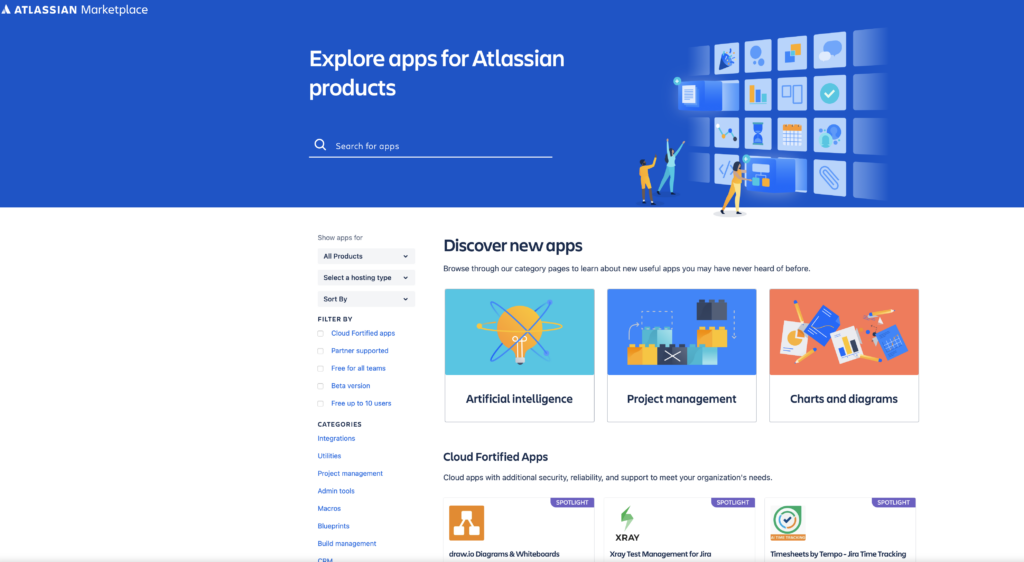 | 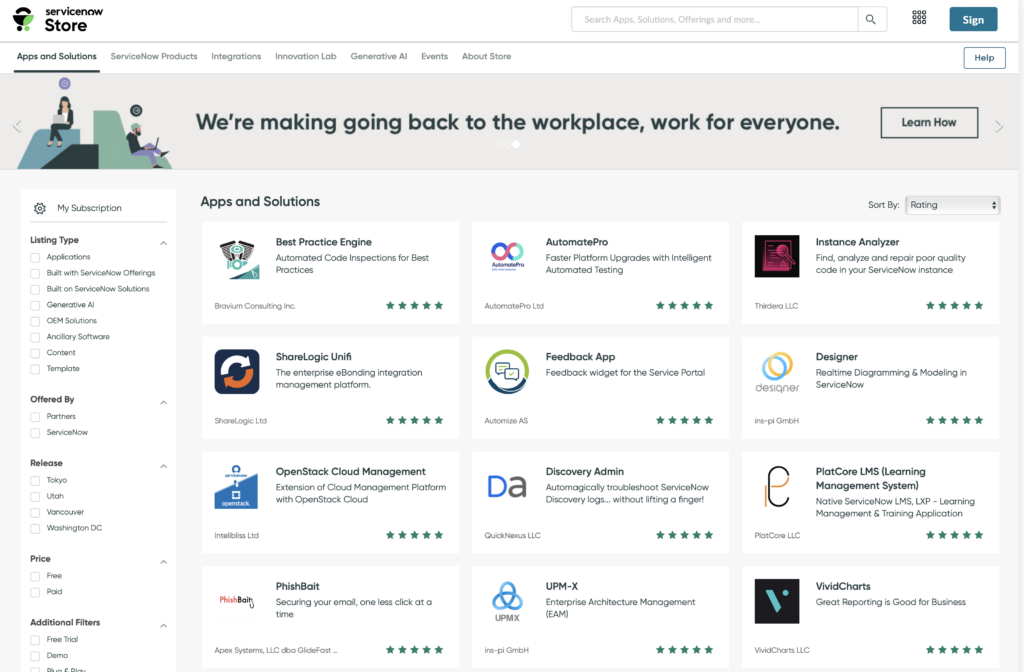 |
Although both have a store for integration apps, the main difference is that Jira Service Management has complete and native integration with Jira Software and Confluence. This means that from the same interface, you can manage incidents, requests, or changes, asset management, agile project management (development lifecycle management and DevOps practices), and the knowledge base. ServiceNow also integrates with Jira Software, but it is not a direct integration.
Market Approach
JSM is really aimed at all types of markets, industries, and teams. While it is true that it is highly recommended for teams with little experience, looking for a quick start, where the tool itself can help you from the start.
There are several templates designed for a wide market of users. This helps in the early stages of using the application, as you quickly and easily apply a pre-configured setup that will allow you to implement a basic service in a short time (they have pre-configured workflows, fields, issue types, request portal, etc.).
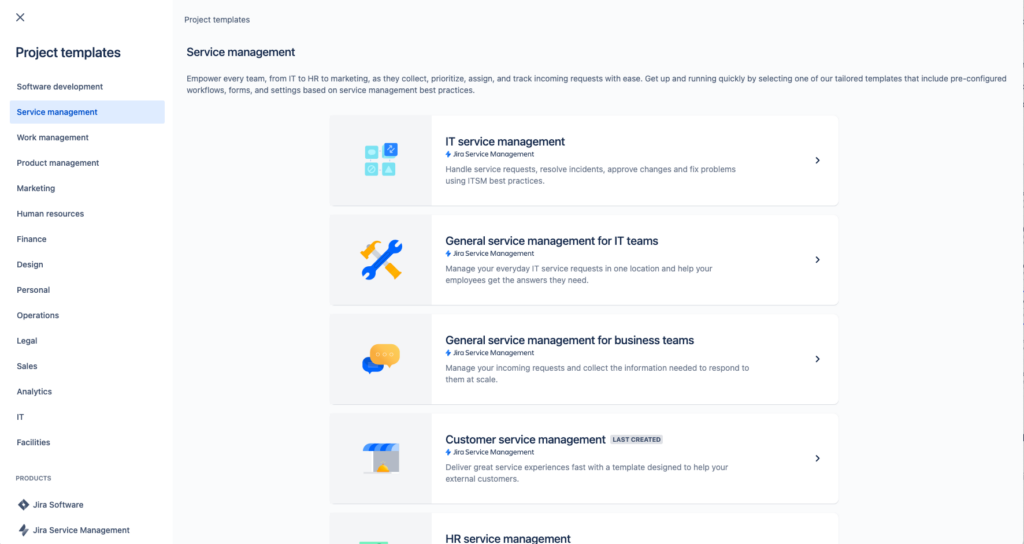
ServiceNow
With ServiceNow, you must choose the product associated with the service you want to manage. If you are not sure which product fits your business by reviewing the catalog on the website, request a demo with the salesperson (available only on demand). Remember that configuring each module requires personnel experienced in setting up this product, as it is not a simple or intuitive task.
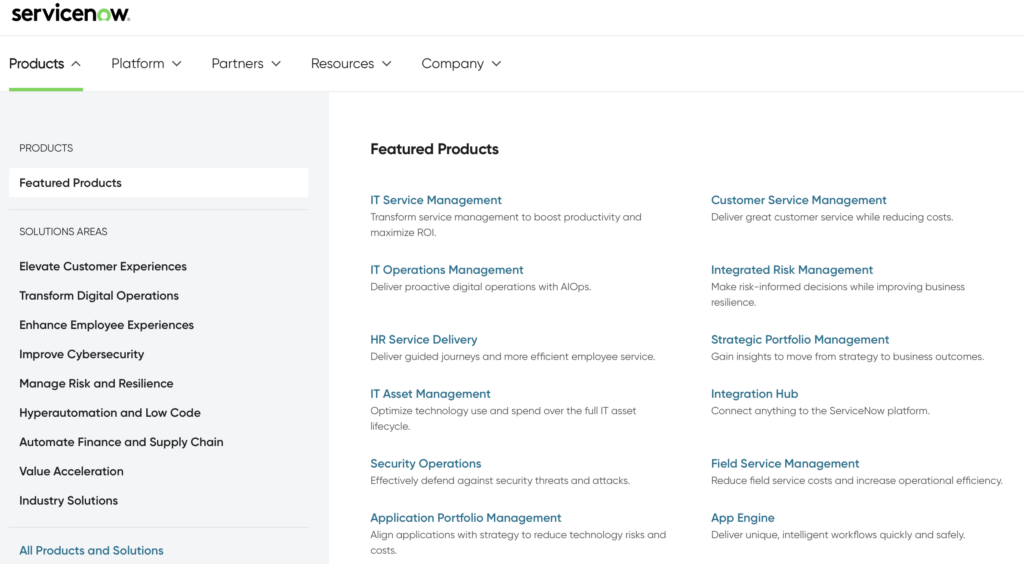
Jira Service Management, on the other hand, offers an intuitive and cost-effective service management solution for all markets, which non-technical teams, such as HR, finance, legal services, marketing, and facilities, can quickly scale and easily maintain. With no-code installation and configuration, teams can develop new services, a customer portal, related request forms, workflow rules, and reports almost instantly. Instead of buying specific modules for each team as with ServiceNow, Jira Service Management customers enjoy a single, adaptable solution flexible enough to solve a wide variety of business problems.
Additionally, integrations on the Atlassian platform connect requests across a complete digital pipeline, from planning, collaboration, and development of tasks and products (Jira Software and Trello) to continuous delivery (Bitbucket), knowledge management (Confluence), operations (Jira Service Management and Statuspage), and asset tracking and inventory management (Assets in Jira Service Management).
Mobile App 📱
The possibility of having a mobile app for the application’s agents is very useful for several reasons:
- Immediate notification of assigned tasks on a corporate mobile phone.
- Instantly resolving tasks even when away from the workstation.
- Creating requests or incidents at any time, from anywhere.
Thanks to download websites (App Store and Play Store in Spain), we can see data on the number of downloads and user ratings. According to reviews and download volume, the Jira app is more well-known and has better reviews.
| Jira Service Management | ServiceNow | |
| Android |  | 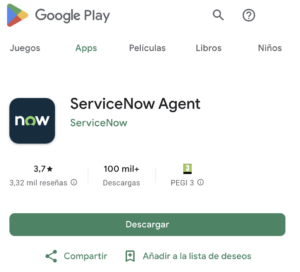 |
| IOS | 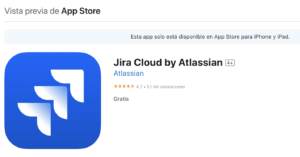 | 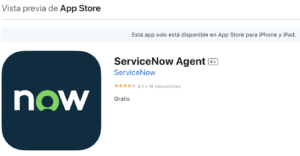 |
Pricing
When talking about prices, it is clear that this is one of the most considered factors in choosing an option. Both platforms’ license prices are subscription-based, and the payment method can be monthly or annually. We will show the differences between both applications in this table.
| Jira Service Management | ServiceNow |
| Atlassian transparently displays prices on its website with no surprises. Both in Cloud and Data Center modes, you can budget with their calculator (see example in the image below), as well as the features each plan offers. | On the other hand, in the case of ServiceNow, to know the prices and available plans is not as transparent. These prices are associated with the number of agents and desired modules but can only be known through a salesperson (requested via their website). This can lead to unknown pricing for each company as it is a direct negotiation. |
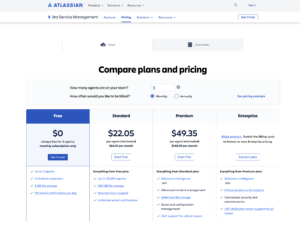 |  |
➡️ It should be noted that, before trying the Jira Service Management product, Jira offers a 7-day trial for a license suitable for up to 10,000 users. Additionally, there is a Free license for each product (limited to 3 agents) with functionality limitations compared to the power provided by Premium or Enterprise licenses.
Conclusion
Although ServiceNow is a very powerful tool that offers comprehensive ITIL coverage, factors such as implementation time, ease of use, and license cost must be weighed. For these reasons, Jira presents itself as a very attractive option that is increasingly being chosen by companies, regardless of the number of employees and departments. JSM offers great flexibility, lower complexity, is much more economical, and easier to use. Other details where Jira excels include the updates it performs throughout the year and the clear and organized documentation available on its website.
If you want to know more, let us know 😉